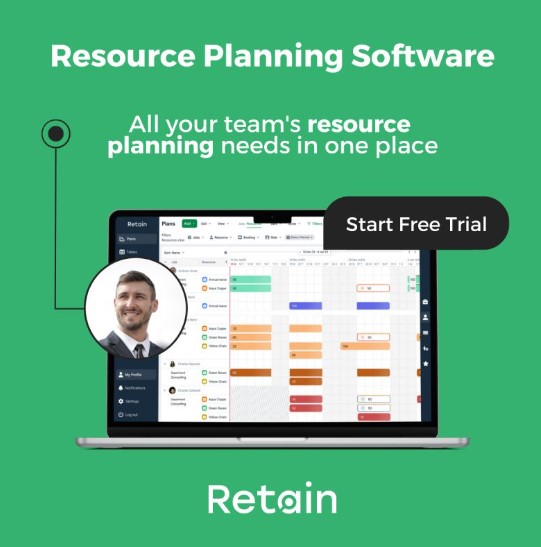Implementing AI can revolutionise resource management for professional services firms. Yet while AI capabilities are maturing rapidly, how do you successfully implement AI in resource management?
Many firms struggle to activate AI's potential. Complex integrations, data issues, and change management challenges can derail efforts.
It doesn’t need to be that way.
This guide provides a roadmap for implementing AI in resource management. It covers key steps like identifying opportunities, getting stakeholder buy-in, integrating AI with existing systems, and monitoring performance. ?
Why implement AI in resource management?
Traditional resource management methods have limitations that AI in resource management tech can help address. Manual processes for forecasting, allocating, and optimising resources rely heavily on gut feel and institutional knowledge. This makes them prone to bias and inefficiency.
But AI delivers data-driven insights and recommendations. It can analyse historical utilisation rates, project timelines, skill sets, and other variables to forecast demand. In fact, AI models can process thousands of complex constraints and options to identify optimised resource plans.
Other key benefits of implementing AI include:
- Increased speed and automation: AI can rapidly generate forecasts and scenarios that would take weeks of manual analysis. Real-time allocation algorithms speed up assignments.
- Enhanced visibility: AI reveals insights like future bottlenecks, underutilised resources, and resourcing gaps. This visibility enables proactive planning.
- Improved resource productivity: Optimised assignments, reduced scramble situations, and better skill-project matching drive higher utilisation and output.
- Reduced costs: AI boosts productivity, which reduces the need for expensive contingent labour. Plus, better forecasts also prevent over-hiring.
In summary, the business case for AI adoption is growing stronger each day. Professional services firms are already using AI for use cases like predicting project needs, matching consultants to new projects, and monitoring real-time utilisation.
So let’s dive into the implementation steps for a simple framework for adopting AI in resource management.?
Key steps for implementing AI in resource management
Successfully implementing AI for resource management requires careful coordination. The steps below provide a framework for activating AI’s potential within your organisation.
?Step 1: Identify the biggest pain points and high-value opportunities
First, analyse where your organisation struggles most with resource management and forecasting. Where are inefficiencies or errors happening? How does poor resource allocation impact the business? Which teams or projects have the biggest resource challenges?
Identify 3-5 high-priority use cases where AI could add significant value, such as improving forecast accuracy for proposal teams, optimising utilisation for client projects, or assigning skills more effectively. (This helps with gaining buy-in for the next step too.)
?Step 2: Secure exec sponsorship and stakeholder buy-in
Any major technology initiative requires executive sponsorship to secure budget and coordinate cross-functional participation. To do help with this, you could educate executives and stakeholders on AI’s proven benefits and potential within resource management.
Also, identify department heads who will need to advocate for AI adoption across their teams. Clarify objectives, priorities, success metrics, and required investments. And develop a change management plan to support users through the transition.
??Step 3: Audit existing data inputs
Next up, start by auditing what resource management data is currently available across systems like timesheets, project management plans, ERP, and HR platforms. Review factors like completeness, accuracy, structure, and accessibility.
Then identify any supplementary datasets that may need to be sourced. Assess gaps in the type of data needed for the preferred AI use cases in step one. After this, you might want to develop a plan to address these gaps, which may involve adding fields to collect new data.
?️Step 4: Evaluate and select appropriate AI tools and applications
Once you’re clear on the above it makes it easier to research vendors offering AI solutions tailored to resource management challenges. Assess factors like ease of integration, model accuracy, and fit to identified use cases.
Options like Retain provide forecasting and optimisation models with extensive reporting customisation and AI transparency while others offer less customisable and more opaque capabilities. Consider conducting proof of concepts with 1-2 vendors before selecting a long-term partner.
?Step 5: Clean and structure data for AI
AI models often require organised data to produce the best and most accurate insights. So assess existing data for completeness, consistency, and relevance. Then identify any gaps that need to be addressed by modifying data collection.
You might want to also clean data by fixing any formatting errors, filling in missing values, removing irrelevant fields, and standardising terms. Some AI tools include data preparation capabilities to profile, clean, and transform datasets.
☁️Step 6: Integrate AI systems with core platforms
Connecting AI tools with existing systems like project management, HRMS, and ERP enables higher-value applications. Potential integrations include embedding AI insights into workflows, triggering automated actions, and syncing data.
Cloud-based AI in resource management tools make this easy and typically offer integration support and documentation. For legacy systems, integration may require middleware.
?Step 7: Start with a pilot project
Pilots focus AI applications on a narrow use case with a limited user group. This allows for controlled testing and refinement before full deployment. Pilot projects also build credibility with stakeholders by demonstrating value.
So identify high priority use cases where AI can make an immediate impact. Then schedule frequent check-ins to gather user feedback during pilots.
By following this phased implementation approach, your organisation can transition to AI-powered resource management. Expect the process to take a couple of months for initial use cases. Plus, there will be an ongoing need for monitoring, maintenance and enhancement.
?Pro tip: Take time to celebrate wins and milestones along the journey. With proper planning and execution, AI can transform how your firm maximises its precious people resources.
While the benefits are compelling, AI implementation also comes with common challenges to anticipate and address throughout the process. Let’s take a look.?
Implementing AI in resource management: Challenges to address
While promising, implementing AI for resource management comes with a few challenges to proactively address:
☑️Data issues: AI models are only as good as the data used to train them. Many firms find their data incomplete, inconsistent, or inaccurate for optimal AI. That’s why careful data auditing and preparation is required, which can take time.
☑️Legacy system integration: Sometimes connecting AI tools with on-prem systems can involve middleware and custom APIs. So make sure you seek help from experts when linking AI to legacy platforms.
☑️Change management: People are integral to AI success. But many staff may feel threatened by AI or lack skills to use it. So try and involve change management leaders from the start.
☑️Model governance: Finally, it helps to implement model performance KPIs and re-training protocols to ensure ongoing accuracy.
?Pro tip: Choosing the right resource management software will help overcome these challenges. So leverage external experts through partnerships or services when it accelerates your AI journey. Stay nimble and expect obstacles - but don’t let them deter AI adoption.
The rewards are worth it.
Implement AI in resource management with Retain
To sum up, as we’ve seen, implementing AI for resource management is a journey - one requiring careful consideration. But the destination is transformation. With AI, your firm can move from reactive scrambling to predictive optimisation.
Don't let the inevitable bumps derail your progress. Data challenges, integration hurdles, reluctant users - obstacles are expected, but surmountable - especially with the right tech. So stay nimble and enlist help when needed.
Your organisation and its customers - your employees - deserve the benefits AI can unlock. More engaging work, reduced burnout, and the ability to perform at new heights.
?This guide provides the roadmap to get there. And Retain provides the software to achieve it.

Now is the time to activate AI's potential within your firm. The future of resource management is here. Will you lead the way? Find out how the right tech can help.


